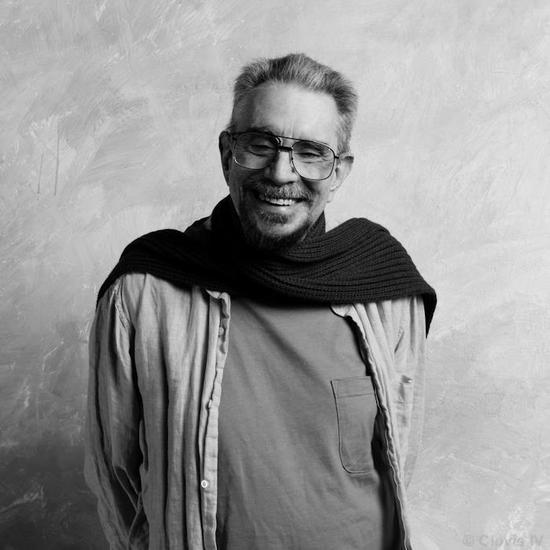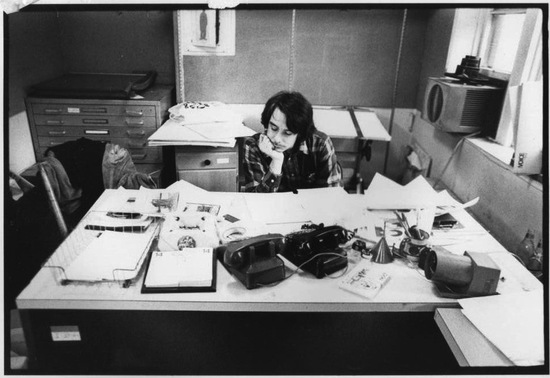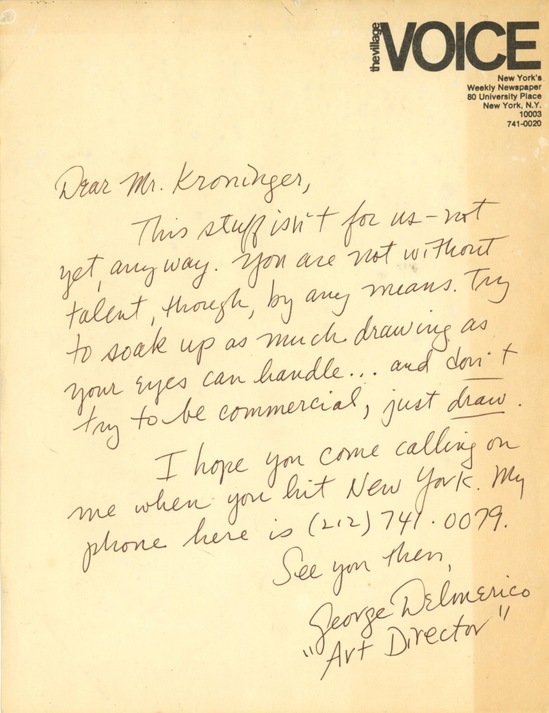Appreciation
09.18.13
Remembering George Delmerico, Longtime Art Director of The Village Voice
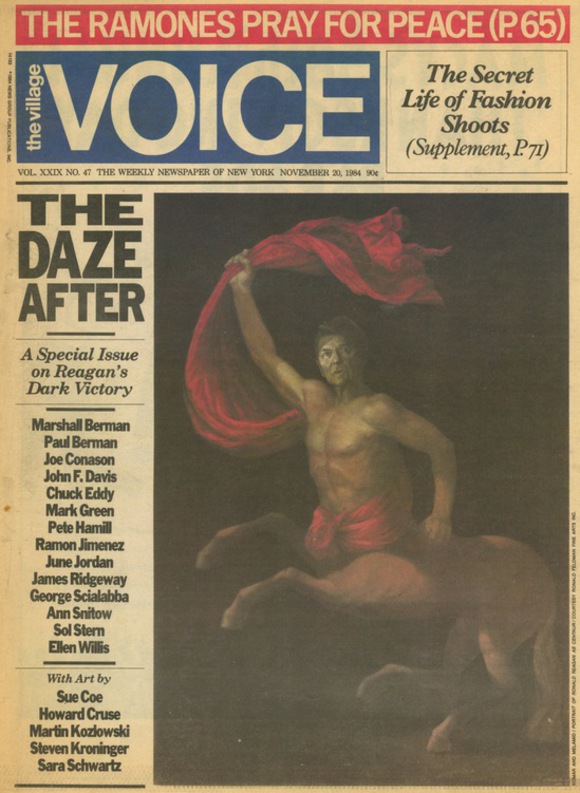
Longtime Village Voice art director George Delmerico passed away in early August in Santa Barbara, California at the age of 67.
Delmerico was a talented and eclectic art director who designed LP covers (most notably Donald Fagen's The Nightfly), posters, books, alternative newspapers, and much more, but it was his work as art director of The Village Voice from 1976-85 where he produced the most memorable and influential imagery. Delmerico took over from previous art director Milton Glaser, and created a design that was notable for its studied elegance, spare use of color and typography, and bold imagery. Delmerico worked with and introduced a generation of Voice photographers and illustrators, including Sylvia Plachy, James Hamilton, Walter Gurbo, Philip Burke, Stephen Kroninger, Mark Alan Stamaty, and many more, while becoming perhaps the most influential alternative weekly newspaper art director of all time.
On the turn page we've collected some of Delmerico's most memorable Voice covers, as well as a remarkable set of remembrances from some of his Village Voice co-workers and collaborators.
(Above): The Village Voice, November 20, 1984. Art director: George Delmerico. Art: Komar and Melamid.
-
The Village Voice, January 17, 1977. Art director: George Delmerico. Photograph: Robert Mapplethorpe.
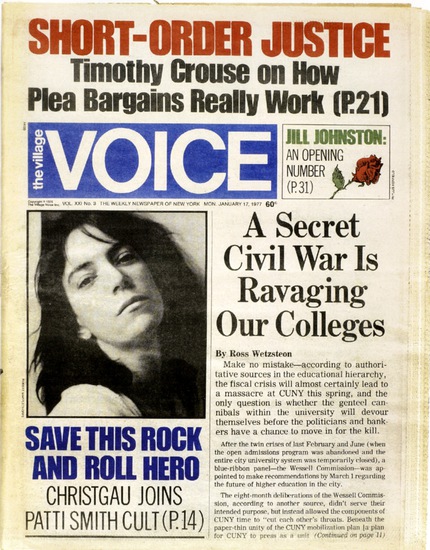
-
The Village Voice, March 11, 1981. Art director: George Delmerico.
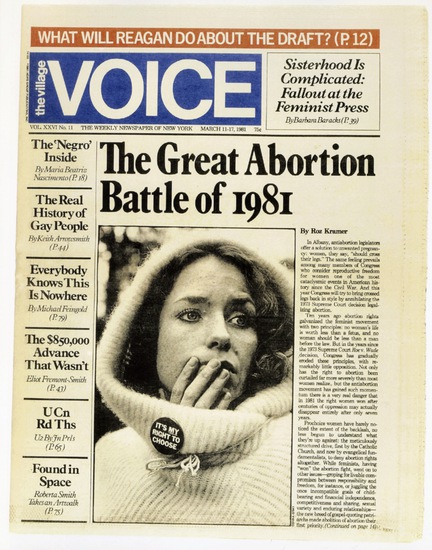
-
The Village Voice, March 2, 1982. Art director: George Delmerico. Photograph: Andy Freeberg.
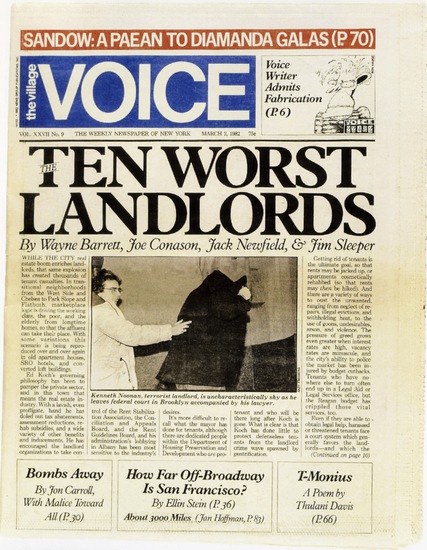
-
The Village Voice, January 15, 1979. Art director: George Delmerico. Photograph of Fred Trump: Fred W. McDarrah.
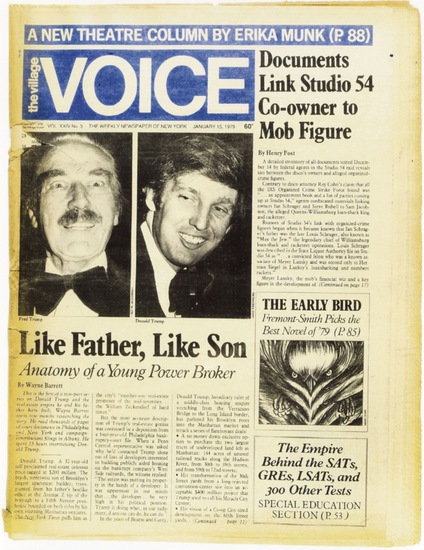
-
The Village Voice, July 17, 1978. Art director: George Delmerico. Photograph of Central Park: James Hamilton.
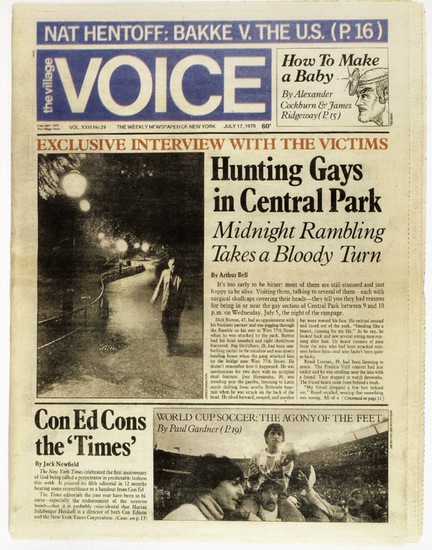
-
The Village Voice, December 10, 1980. Art director: George Delmerico. Photograph: Jack Mitchell.
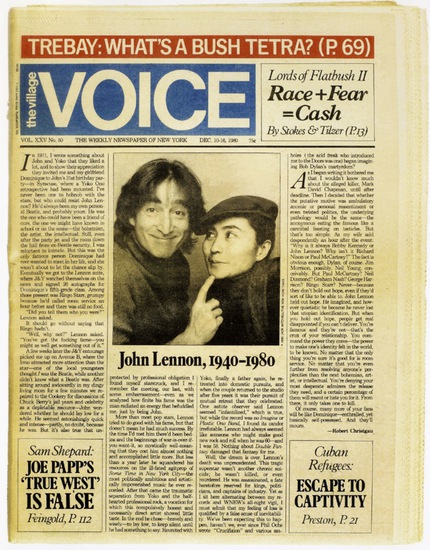
-
The Village Voice, October 1984. Art director: George Delmerico
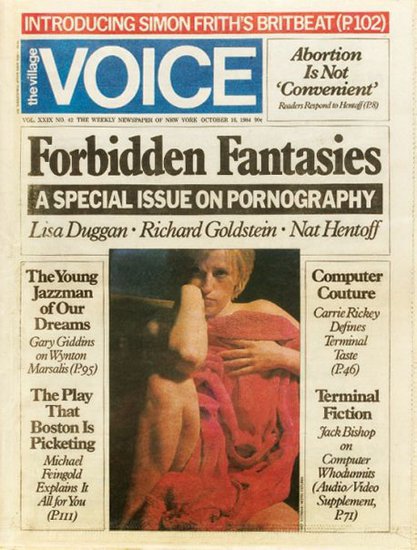
-
The Village Voice. Art director: George Delmerico.
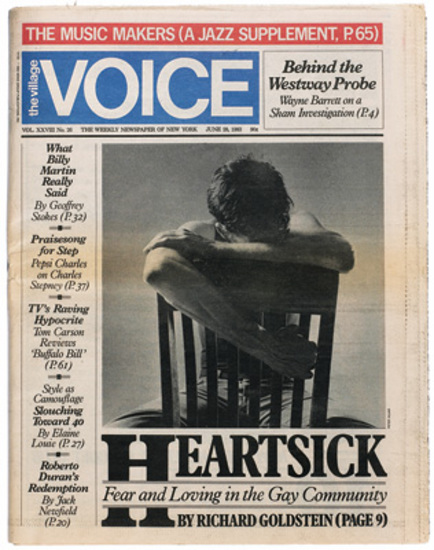
The Voice in the 70s and 80s was a vital, pulsing, document of the social, cultural, and political heartbeat of the city, especially that part of it below 14th Street. If you were young, hip, gay, progressive, a feminist, The Voice was your source for news of all kinds. In those days The Voice was a newsstand-driven publication, and people would line up late on Tuesday nights to grab early copies. Delmerico created the visual voice of The Voice that jumped off the newsstand. It was brash, funny, powerful, gritty, and always smart and elegant; the kind of newspaper cover design that has never been seen before or since. The paper was produced in the age of Atex and pasteup, but I still marvel at the sophistication and attention to detail that Delmerico brought to every page.
I was living in Seattle while Delmerico was art director, and I would rush every week to get one of the handful of copies of The Voice that were sold at the Read All About It newsstand in the Pike Place Market. I would study everything about the design, right down to the little photo and illustration credits on the side. I marveled at Delmerico's ability to create diverse, engaging, surprising, and provocative covers week after week. And I found inspiration (heck, I just plain copied those Voice covers!) from his work and applied it to numerous ragtag newspapers that I worked on in my early days.
Delmerico inspired me to work as an alternative newsweekly art director, and later to move to New York City (much thanks to Michael Grossman) and become an art director and later design director at The Voice. It was a dream come true. I would work hard on what I thought were great covers, and then would go upstairs to the production department and be humbled by the collection of Delmerico-era Voice covers framed on the walls. No matter how hard I tried, I could never duplicate that supreme cohesive quality that Delmerico brought to his covers, blending tough New York City tabloid attitude with cool, sophisticated elegance, creating a visual language that was compelling and engaging.
Delmerico was the perfect art director for The Voice. He was smart and passionate, and a great visionary. What he did so brilliantly was provide a venue for the many visual voices, the artists and photographers and image-makers of the paper to speak. He gave them space, room to grow and connect with the readers. He brought visuals into the world of what was at the time an aggressively word-oriented publication, and gave them life. The Village Voice is woefully archived these days. With the exception of some scattered microfiche-based scans that live on the Google Newspapers site, it's not possible to find a decent collection of Delmerico-era Voice covers. We've collected a few of our favorites in a slideshow on this page, and welcome any other additions.
Here are some memories of George Delmerico by some of the many talented people who worked with him at The Village Voice.
I was living in Seattle while Delmerico was art director, and I would rush every week to get one of the handful of copies of The Voice that were sold at the Read All About It newsstand in the Pike Place Market. I would study everything about the design, right down to the little photo and illustration credits on the side. I marveled at Delmerico's ability to create diverse, engaging, surprising, and provocative covers week after week. And I found inspiration (heck, I just plain copied those Voice covers!) from his work and applied it to numerous ragtag newspapers that I worked on in my early days.
Delmerico inspired me to work as an alternative newsweekly art director, and later to move to New York City (much thanks to Michael Grossman) and become an art director and later design director at The Voice. It was a dream come true. I would work hard on what I thought were great covers, and then would go upstairs to the production department and be humbled by the collection of Delmerico-era Voice covers framed on the walls. No matter how hard I tried, I could never duplicate that supreme cohesive quality that Delmerico brought to his covers, blending tough New York City tabloid attitude with cool, sophisticated elegance, creating a visual language that was compelling and engaging.
Delmerico was the perfect art director for The Voice. He was smart and passionate, and a great visionary. What he did so brilliantly was provide a venue for the many visual voices, the artists and photographers and image-makers of the paper to speak. He gave them space, room to grow and connect with the readers. He brought visuals into the world of what was at the time an aggressively word-oriented publication, and gave them life. The Village Voice is woefully archived these days. With the exception of some scattered microfiche-based scans that live on the Google Newspapers site, it's not possible to find a decent collection of Delmerico-era Voice covers. We've collected a few of our favorites in a slideshow on this page, and welcome any other additions.
A memorial service for George Delmerico is being held in Santa Barbara, CA on September 22. There's a memorial page on Facebook with more information and more memories of Delmerico's life and work. An East Coast memorial will be held in Delmerico's home town of Dobbs Ferry, NY, on October 12.
Many thanks to George's partner Ken Volok and Village Voice associate art director Jesus Diaz for extensive help in producing this remembrance.
Stan Mack, cartoonist: In 1977, Stan featured George in his long-running comic strip, "Stan Mack's Real Life Funnies." The occasion was the redesign of The Voice, and George appears in the first panel and several others. Click on the cartoon to see a full-size version!
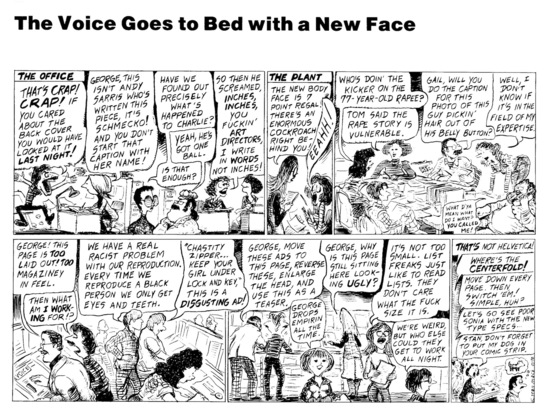
James Hamilton, staff photographer: George was a sweet and loving soul and he passed on that sweetness, generosity and passion to the work of every artist I know. No art director was ever more considerate of my work and I really can't tell his story without telling mine as well. George and I had met at Pratt in 1964 and immediately became friends. I left after my second year, worked for a photographer, and then went out on my own. George designed the Pratt yearbook (a big honor), graduated, and went on to work as a designer at a number of terrific places. Our lives intersected again when, in early '71, he and I (coincidently) were the first hires at a new weekly newspaper called The Herald by a brilliant designer named Massimo Vignelli. That is where our real friendship began. It was also where I discovered George's love of photography. He cherished art and artists, gave them their head and presented the work beautifully. The Herald won a number of design awards, but had a short life, at least for George and me. George left and I moved to be the staff photographer at Harper's Bazaar. We remained great friends and joined again in our conspiratorial collaboration (we called it) at The Village Voice. I had been hired as staff photographer in '75 and George was brought in to art direct in '76. Along with the inherent freedom within The Voice (low pay), George allowed me even more. Every photographer and illustrator will confirm--he loved artists the way that a good director loves actors. And he loved journalism. He cared deeply about the paper and managed to respect every contribution in the same calm, caring way (not easy on a weekly, let alone as contentious a place as The Voice was). I wound up being offered the photography in a book about (of all things) pinball, so of course I brought George in to design. Because of that it was on The New York Times list of 10 best Christmas books in 1977. George and I worked together until 1985 when he left for Santa Barbara to design The Independent, a paper founded by our former boss, editor Marianne Partridge. We maintained long distance contact but never worked together again. Though I've tried here, I really owe George more than I can say. No one gave me more support, freedom or opportunities in my work than he. And I never had a more loving friend.
Mark Alan Stamaty, cartoonist: George Delmerico was a very nice guy, a pleasure to work with and the person--more than anyone else--who made it possible for me to have many wonderful years appearing in The Village Voice.
I first met George when he was an art director at The New York Times in the 1970s. He loved my children's book Who Needs Donuts? and I kept in mind that he did.
Sometime in the following year, George became art director at The Voice. I had been feeling some frustration with the limits of children's books in those years and had been thinking that The Voice might offer an ideal adult readership for the sort of work I hoped to do. A place where I might be able to expand the sensibilities and possibilities of my work. When I heard that George had been hired at The Voice, it seemed very fortuitous.
So I went to see him there and proposed a couple of things. One was a two-page spread drawing of Greenwich Village in the detailed, gag-filled style of Who Needs Donuts? I also told him I was interested in doing a weekly feature. George said getting a weekly feature in The Voice was usually a quite difficult thing to do. But he offered a strategy. He expressed great confidence that if I did the Greenwich Village spread in the same vein as Who Needs Donuts? it would be a big hit, attract a lot of positive attention and create a very receptive environment in which he could suggest to the editors that I be given a weekly feature. And George was right. As soon as my Greenwich Village spread appeared and editors and staff were feeling the feedback, George jumped right in and got me a small weekly comic strip that started out on the Letters pages then, after a few weeks, got moved to the Classifieds.
George was wonderfully supportive all the way. With my "stock" rising in The Voice office, I suggested I do another city spread--this time of Times Square. George was totally onboard. When he proposed it at a staff meeting, there was some concern expressed that a cartoon of the then-raunchy Times Square might end up being quite sexist. George assured everyone that it wouldn't be. He handled the office politics beautifully and also passed on those concerns to me.
While I was working on the Times Square picture, George called me up one day to tell me the news that Stan Mack and Ed Sorel--two of the three cartoonists (along with Feiffer) who had large comic strips in the upfront pages--would be leaving The Voice to work for Clay Felker's remake of Esquire magazine. So there would be two openings for two new large comic strips upfront and George (bless his soul) had thought immediately of me. And he told me that what I needed to do was make an appointment with our editor, Marianne Partridge, right away. Which I did.
My meeting with Marianne went well. She was interested, but she said I had to show her something. So I went home and created the beginnings of MacDoodle St.Two weeks later, I showed her the first two episodes and tossed various additional sketches of characters and ideas of where it might be headed and she bought it! And there I was with my own nearly half-page strip in The Voice in the company of my hero, Jules Feiffer, on the preceding page. And all thanks, really most of all, to George's openness to new ideas, his creative spirit and generous heart. He was a very good man.
And George was also very much in love with what he did. I remember visiting him in his small apartment on Sheridan Square back in those days. My memory is that his apartment was actually in the upstairs of that tiny building that had been The Voice offices before The Voice moved to University Place. I believe the building is still there. It is shaped like a triangle, if I'm recalling correctly. And what I remember about George's apartment was that on his wall he had one or two large framed sketches of front page designs for newspapers that he had done in high school. In my memory, they might have been done on newsprint paper and possibly in dark pencil. And George described to me with great intensity how much, from a young age, he'd wanted to do EXACTLY what he was doing--designing newspaper pages. And how happy he was to have the very job he had.
George was a good friend and a great person to work with and for. He admired and respected artists. He looked for opportunities to give us space and freedom to do what we do best and enjoy doing it. He respected artists' visions and he took on the office politics to promote and protect us and pave the way for us to do the work that we and he believed in.
Allen Reuben, assistant photo editor: In many years of working with and observing George deal with ridiculous impossible deadlines, including all the problems and personalities, the phrase "grace under pressure" describes him in every way. He was an immense talent, inspiring spirit and guiding hand to all. And the greatest friend anyone could ever hope to have. A tremendous loss. (Photograph of George Delmerico in his office by Allen Reuben.)
During an era when many high-profile newspapers--and certainly most alternative weeklies--were exploring the extremes of their newfound color and type capabilities, he kept himself in a visual straitjacket, barely using more than one typeface (the oh-so-unhip Plantin), and almost no color (black, the blue of the logo, and usually no more than a single element in red). But within that tight constraint, he managed to celebrate the paper's wildly disparate content brilliantly, in a quilt of headline blocks, where butting elements might be as dissimilar as stories can be. Dead serious next to whimsical; snarky next to earnest; traditional next to avantgarde; investigation next to cartoon illustration--he deftly balanced the demands of the paper's then- constantly bickering internal factions.
At a time when The Voice's voices were anything but harmonious, George charted a daring arrangement that somehow let everyone solo, side-by-side.

Sylvia Plachy, staff photographer: George brought his sense of elegance to The Voice, he gave photographs space and importance. He had a rare talent, he understood the language of photographs. He showcased them so no one could miss their meaning.
I was still shy then, my pictures whispered, but George amplified them; ran them large. He didn't crop. He didn't take away the black line. He made photographs equal to words.
During his tenure I had a picture with no caption featured on the contents page each week. It was George's idea to make the title with bold letters above the photograph, almost like a marquee on a theater, instead of the usual photographer's credit, tiny and on the side.
To refresh my memory I pulled out tearsheets from those years from my filing cabinet. They are yellow, they crumble to the touch, but they are beautiful, effortless compositions of type and image; straightforward, lively, unpretentious, gentle yet solid like George. I almost forgot.
I miss him.
Ernie Lynk, staff designer: I have fond memories of George and all the great work we did together. It was an incredible time in New York with the arts scene and public health issues like AIDS. I remember it was so new that we didn't know how to spell it--whether it should have periods after each letter or not. George was not only a great designer with sensitivity and attention to detail, especially typography, he was also a journalist in the truest sense of the word. But rather than words as his expressive device he used page design and typography and photography and illustration to get the information across. And George knew and understood the issues; whether it was politics or art he understood the message. eorge was never a passive bystander in editorial meetings. He always had his opinion and it was always respected. I'm grateful to have worked with him and will always remember him giving me the opportunity to work with all of the other gifted and wonderful people at the Voice. It was one of the great times of my life.
Mark Alan Stamaty, cartoonist: George Delmerico was a very nice guy, a pleasure to work with and the person--more than anyone else--who made it possible for me to have many wonderful years appearing in The Village Voice.
I first met George when he was an art director at The New York Times in the 1970s. He loved my children's book Who Needs Donuts? and I kept in mind that he did.
Sometime in the following year, George became art director at The Voice. I had been feeling some frustration with the limits of children's books in those years and had been thinking that The Voice might offer an ideal adult readership for the sort of work I hoped to do. A place where I might be able to expand the sensibilities and possibilities of my work. When I heard that George had been hired at The Voice, it seemed very fortuitous.
So I went to see him there and proposed a couple of things. One was a two-page spread drawing of Greenwich Village in the detailed, gag-filled style of Who Needs Donuts? I also told him I was interested in doing a weekly feature. George said getting a weekly feature in The Voice was usually a quite difficult thing to do. But he offered a strategy. He expressed great confidence that if I did the Greenwich Village spread in the same vein as Who Needs Donuts? it would be a big hit, attract a lot of positive attention and create a very receptive environment in which he could suggest to the editors that I be given a weekly feature. And George was right. As soon as my Greenwich Village spread appeared and editors and staff were feeling the feedback, George jumped right in and got me a small weekly comic strip that started out on the Letters pages then, after a few weeks, got moved to the Classifieds.
George was wonderfully supportive all the way. With my "stock" rising in The Voice office, I suggested I do another city spread--this time of Times Square. George was totally onboard. When he proposed it at a staff meeting, there was some concern expressed that a cartoon of the then-raunchy Times Square might end up being quite sexist. George assured everyone that it wouldn't be. He handled the office politics beautifully and also passed on those concerns to me.
While I was working on the Times Square picture, George called me up one day to tell me the news that Stan Mack and Ed Sorel--two of the three cartoonists (along with Feiffer) who had large comic strips in the upfront pages--would be leaving The Voice to work for Clay Felker's remake of Esquire magazine. So there would be two openings for two new large comic strips upfront and George (bless his soul) had thought immediately of me. And he told me that what I needed to do was make an appointment with our editor, Marianne Partridge, right away. Which I did.
My meeting with Marianne went well. She was interested, but she said I had to show her something. So I went home and created the beginnings of MacDoodle St.Two weeks later, I showed her the first two episodes and tossed various additional sketches of characters and ideas of where it might be headed and she bought it! And there I was with my own nearly half-page strip in The Voice in the company of my hero, Jules Feiffer, on the preceding page. And all thanks, really most of all, to George's openness to new ideas, his creative spirit and generous heart. He was a very good man.
And George was also very much in love with what he did. I remember visiting him in his small apartment on Sheridan Square back in those days. My memory is that his apartment was actually in the upstairs of that tiny building that had been The Voice offices before The Voice moved to University Place. I believe the building is still there. It is shaped like a triangle, if I'm recalling correctly. And what I remember about George's apartment was that on his wall he had one or two large framed sketches of front page designs for newspapers that he had done in high school. In my memory, they might have been done on newsprint paper and possibly in dark pencil. And George described to me with great intensity how much, from a young age, he'd wanted to do EXACTLY what he was doing--designing newspaper pages. And how happy he was to have the very job he had.
George was a good friend and a great person to work with and for. He admired and respected artists. He looked for opportunities to give us space and freedom to do what we do best and enjoy doing it. He respected artists' visions and he took on the office politics to promote and protect us and pave the way for us to do the work that we and he believed in.
Allen Reuben, assistant photo editor: In many years of working with and observing George deal with ridiculous impossible deadlines, including all the problems and personalities, the phrase "grace under pressure" describes him in every way. He was an immense talent, inspiring spirit and guiding hand to all. And the greatest friend anyone could ever hope to have. A tremendous loss. (Photograph of George Delmerico in his office by Allen Reuben.)
Stephen Kroninger, illustrator: Back in the late seventies, I was an art school student in Kutztown, Pennsylvania--the art editor and illustrator/cartoonist for the school paper. The editor subscribed to The Village Voice and I would see it every week. At some point I collected a bunch of my drawings, the original art as I was a very naive kid, and sent them to George Delmerico.
George returned everything and wrote a note saying that if I were ever in New York, I should look him up. So, I decided to quit school, move to New York and take him up on his offer to give him a call. And I did just that.
In New York, I was living in a cheap hotel and had to call him from a pay phone. George seemed surprised to hear from me but he was nice enough to invite me up to his office. I think it was the quitting school and moving to New York that persuaded him. he couldn't have been nicer, but he didn't give me any work. At least not yet.
At some point George asked me if I could caricature classic movie stars for a weekly spot featuring films playing in the local revival house. He asked me if I'd ever heard of William Auerbach-Levy as that was the kind of style he was looking for. I hadn't. In those days The Voice offices were down the street from the Strand Bookstore. As chance would have it they had a copy of The Art of Caricature. I went home and, the statute of limitations has run on this so I feel it's safe to reveal, I copies line for line some of Levy's work and presented the drawing to George as my own. He loved them but, alas, the films in revival column was discontinued.
I started mailing George a new drawing, a doodle really, with a catchy saying on it every day. I thought I was clever. George thought I was a mad stalker. Eventually he stopped opening them and they became a huge pile on his desk as I learned later when he called me into his office.
Things changed one night when my good friend Philip Burke called me at two in the morning. We all stayed up late in those days. I still do. Anyway, Philip said, insisted, that I come over to George's apartment in the Village immediately. I did. He may have asked me to bring some sketchbooks.
I arrived to find the both of them smoking pot and the atmosphere not very business-like. I learned later that George was telling Philip that he thought I was scary. Philip started shouting at George, "No, he's a genius!" Hence, by invitation to join them. We didn't talk about art. I mostly remember George that night, sitting on the edge of his bed telling us of the prophecies of Nostradamus. This went on past dawn.
I must have passed the sanity test for soon after my work began appearing in The Village Voice. I did one of my first collages for George at The Voice. I'll never forget standing in the art department there seeing my printed image for the first time and George leaning over to whisper into my ear, "You're on your way."
I spoke to George on the phone a year or so ago and told him all of this and how his original letter hangs framed on the wall in my studio. I was glad to hear that he seemed to be living the good life by the ocean. I owe him so much. I've worked with a lot of great art directors over the years. George certainly ranks among the best of the best.
Richard Goldstein, senior editor: When I arrived at The Village Voice in 1966, the paper had a design that could only be called minimal. Articles were laid out around tiny ads like clothes on a line; your piece could jump backwards and forwards several times. That changed when Clay Felker bought the paper in 1974. Milton Glaser, who was Felker's associate, created a novel design template that included two front pages, and my job as arts editor was to provide features for the rear front page, which was dedicated to cultural news. It was a visually chaotic operation until, suddenly, George Delmerico appeared. Working for a small desk in a corner of the office, he responded eagerly to all sorts of weird assignments (this being The Voice). "What are your art needs," he would say in a voice that was hardly dictatorial, and as often as not you didn't know. He would have to make the piece in question come alive.
He did that by bringing onto the paper a stable of photographers and artists who had in common a clean, often fold look--the visual equivalent of sans-serif type. Sometimes George and I would work on layouts in his apartment, a classic Greenwich Village garret, and sometimes we would be in the office until late at night collaborating on the final look of a page. What I got from those session was a sense of how elegant and vivid even the most discursive prose could become with the right visual treatment. "Everything you see is designed," George would tell me. This was something that I, as a word person, had never thought about. But I'd always been fascinated by newspaper layouts, and at some point George showed me large pages that he'd designed as a teenager; tabloid and standard-sized layouts for made-up newspapers. I'd done the same thing as a kind. As much as anything, this was the basis of our bond.
I don't know much about design, so I can't go into any detail about how George helped to define The Voice during his long tenure. But everything that went into that paper reflected his eye. And, I like to think, his heart.
Jesus Diaz, current associate art director, The Village Voice: What I remember of George was that he seemed to always be trotting from one place to another, say, into his office, his head slightly angled to the ground, and not a wasted step with a hundred thoughts clashing. And yet his hello's were the warmest. His kindness reflected by those he hired and worked with (photographers Sylvia Plachy, James Hamilton and designers Ernie Lynk and Stephanie Hill). I'm sure I'm missing others. And yes, his battles with Fred W. McDarrah were open field confrontations. George's cry of "Fuck you, Fred!" was heard often. That shouldn't be surprising from two talented souls who gave a shit. RIP, GD.
Eric Palma, illustrator: back as a student at SVA I did some illustrations for the school newspaper Canvas, and George Delmerico was its faculty-advisor, or teacher. I attended the class for two years, and during that time George also gave me work at The Voice, where he was art director.
Anyhow, I have fond memories of working for George. He instilled in the staff of Canvas a feeling of teamwork, and integrity of craft. To many of us, George was like a soft spoken mentor--always encouraging, and always smart in his critique (he was pretty well versed in American culture and politics, so we had to stay on our toes). I gladly gave my best effort for those assignments in part because I couldn't let George down. When George was replaced by Michael Grossman at The Voice, I remember him telling me that it's normal and healthy for changes to be made under new management. He thought Grossman was young and talented and deserved the position. And faced with what to do next, he made a pretty big change himself and moved West. I last spoke with George (by phone) a few years ago after 25 years of no contact. He seemed very happy and comfortable with his life in Santa Barbara.
Michael Grossman, design director, The Village Voice, 1985-90: I never had the privilege of meeting George, but as one of his successors as The Voice design director, I always admired his bravely counterintuitive approach to the paper's design.
Jesus Diaz, current associate art director, The Village Voice: What I remember of George was that he seemed to always be trotting from one place to another, say, into his office, his head slightly angled to the ground, and not a wasted step with a hundred thoughts clashing. And yet his hello's were the warmest. His kindness reflected by those he hired and worked with (photographers Sylvia Plachy, James Hamilton and designers Ernie Lynk and Stephanie Hill). I'm sure I'm missing others. And yes, his battles with Fred W. McDarrah were open field confrontations. George's cry of "Fuck you, Fred!" was heard often. That shouldn't be surprising from two talented souls who gave a shit. RIP, GD.
Eric Palma, illustrator: back as a student at SVA I did some illustrations for the school newspaper Canvas, and George Delmerico was its faculty-advisor, or teacher. I attended the class for two years, and during that time George also gave me work at The Voice, where he was art director.
Anyhow, I have fond memories of working for George. He instilled in the staff of Canvas a feeling of teamwork, and integrity of craft. To many of us, George was like a soft spoken mentor--always encouraging, and always smart in his critique (he was pretty well versed in American culture and politics, so we had to stay on our toes). I gladly gave my best effort for those assignments in part because I couldn't let George down. When George was replaced by Michael Grossman at The Voice, I remember him telling me that it's normal and healthy for changes to be made under new management. He thought Grossman was young and talented and deserved the position. And faced with what to do next, he made a pretty big change himself and moved West. I last spoke with George (by phone) a few years ago after 25 years of no contact. He seemed very happy and comfortable with his life in Santa Barbara.
Michael Grossman, design director, The Village Voice, 1985-90: I never had the privilege of meeting George, but as one of his successors as The Voice design director, I always admired his bravely counterintuitive approach to the paper's design.
During an era when many high-profile newspapers--and certainly most alternative weeklies--were exploring the extremes of their newfound color and type capabilities, he kept himself in a visual straitjacket, barely using more than one typeface (the oh-so-unhip Plantin), and almost no color (black, the blue of the logo, and usually no more than a single element in red). But within that tight constraint, he managed to celebrate the paper's wildly disparate content brilliantly, in a quilt of headline blocks, where butting elements might be as dissimilar as stories can be. Dead serious next to whimsical; snarky next to earnest; traditional next to avantgarde; investigation next to cartoon illustration--he deftly balanced the demands of the paper's then- constantly bickering internal factions.
At a time when The Voice's voices were anything but harmonious, George charted a daring arrangement that somehow let everyone solo, side-by-side.
